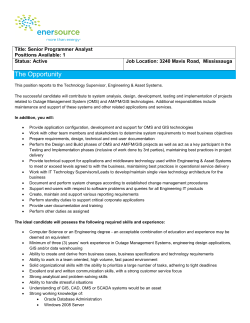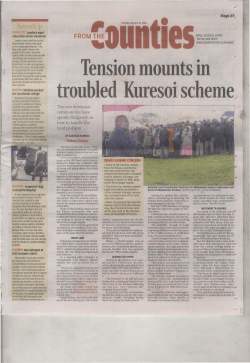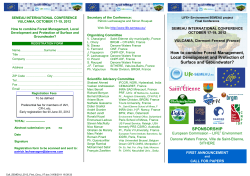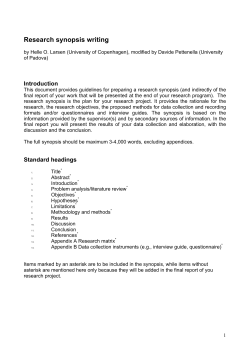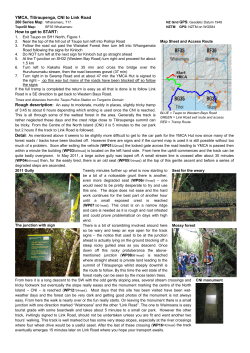
WG3-LULUCF Sector: How to Utilize RS and GIS Data for LULUCF Inventory y
WG3-LULUCF Sector: How to Utilize RS and GIS Data for LULUCF Inventory y Chairperson: Rahim Nik (Malaysia) Rapporteur: Rizaldi Boer (Indonesia) Takahiko Hiraishi (Japan), Savitri Garivait (Thailand), Takako Ono ((Japan), p ), Lee Kyeong-hak y g ((Korea), ), Noriko Kishimoto (Japan), Yasumasa Hirata (Japan), Hyun Kook Cho (Korea), U Than Naing Win (Myanmar) Junko Akagi (Japan) (Myanmar), Objectives • To share experience and lesson learnt in applying RS and GIS data for LULUCF inventory • To discuss actual application of RS and GIS data for LULUCF inventoryy Points for discussion 1 H 1. How d do we id identify tif or estimate ti t concrete t data by applying RS and GIS data? 2. How do we verify RS and GIS data? 3. What kind of resource necessary for g RS and GIS data? utilizing 4. What type of institutional arrangement is effective for applying RS and GIS data for LULUCF inventory? 1, 2 and 3. How do we identify or estimate concrete data by applying RS and GIS data and their verification as well resources required for that? • There are three presentations – The Th use off Global Gl b l M Map ffor addressing dd i CC (Noriko Kishimoto) – Application of RS for forest inventory for identifying DD (Yasumasa Hirata) – Thailand’s experience in using RS and GIS data for estimating (Savitri Garivait) • Global Map containing land cover data of the globe released in 2008 is d downloadable l d bl ffor ffree th through h website b it –URL: www.iscgm.org www iscgm org –E-mail: sec@iscgm.org @ g g (for any inquiries) • Scale: 1:1000,000 Progress g of Global Mapping pp g Project j Example of interpretation Interpretation requires further consideration GM LC 20 Classes LULUCF 6 Classes Broadleaf Evergreen Forest Forest land Broadleaf Deciduous Forest Forest land Needleleaf Evergreen Forest Forest land Needleleaf Deciduous Forest Forest land Mixed Forest Forest land Tree Open p Forest land Mangrove Forest land Shrub Grassland Herbaceous Grassland Herbaceous with Sparse Tree/Shrub Grassland Sparse vegetation Grassland Cropland Cropland Paddy field Cropland Cropland/Other Vegetation Mosaic Cropland Wetland Wetlands Urban Settlements Bare area, consolidated (gravel, rock) Other land Bare area, consolidated (sand) Other land Snow/Ice Other land Water Other land The challenges of forest monitoring Object-Oriented Classification can be used to differentiate the texture up to forest canopy condition, this is potential for 5 defining level of degradation of the secondary forest forest. Deforestation (Area) Deforestation (Area) Forest vs. Non-forest Deforestation (Carbon stock) ( ) Classification of forest types Degradation Incremental change Crown extraction by high resolution satellite More challenging ! • Dr Dr. Garivait (Thailand) presented specific application of RS and GIS in estimating pollutants emissions from biomass open burning (forest fire, rice husk/straw burning and garbage burning) in Mekong River Basin g will affect rainfall • It was indicated that biomass burning pattern and acidity and Ozone formation. Particle matter from biomass burning may inhibit the formation of cloud • The use of MODIS data is highly underestimate for hot spot data, particularly area for agriculture burning • Problem, when fire occur, the satellite already pass over the sites (1x1 km, this is too large). Need to cross check with data from forest fire control statistics and ground survey, but still use many assumption is getting an g efficiency y estimates for biomass and burning 1, 2 and 3. How do we identify or estimate concrete t data d t by b applying l i RS and d GIS d data t and their verification as well resources required i d ffor th that? t? • A margin error may occur when Global Data is applied to national context, thus a country should take care of this • Many of GIS experts in developing countries have not been exposed to the application of RS and GIS in climate change • More ground data is required for verifying the use of RS and GIS data, data in particular for estimating EF and RF data (carbon stock of the five pools) 1, 2 and 3. How do we identify or estimate concrete t data d t by b applying l i RS and d GIS d data t and their verification as well resources required i d ffor th that? t? • Need training for RS and GIS experts on utilization of RS and GIS data for climate change, in particular GHG Inventory • Need to explore the use RS technology for estimating peatland C-stock such as ALOS (can estimate with reasonable accuracy) 4. What type of institutional arrangement is effective for applying RS and GIS data for LULUCF inventory? • Different country has different institutional arrangement for effective use of RS and GIS data for LULUCF Inventory (e.g. ( Indonesia has set up alliance off 18 institutional who has RS and GIS base data; Korea set up the inventory team within one institution ~ effective coordination) • Need to engage GIS experts and RS agencies within the country. • Many global datasets available and can be accessed freely by developing countries to improve their inventory 4. What type of institutional arrangement is effective for applying RS and GIS data for LULUCF inventory? • Next year Activities: – Need to have further discussion on identification of gaps, barriers and approaches in producing high quality National GHG inventory especially in obtaining data needs (many Asia countries have complete their inventory) – How to acquire relevant data nationally and globally for GHG Inventory (training GIS expert on the deriving AD and EF from global data) – What will be national system to support the development of high quality inventory in subsequent National Communication – Need to merge g Agriculture g and LULUCF experts p and RS and GIS experts in the application of RS and GIS data for AFOLU
© Copyright 2025
